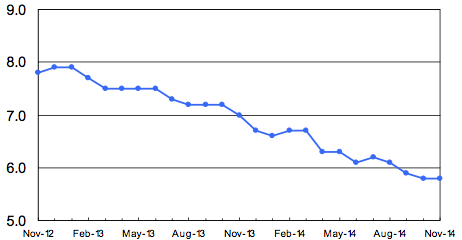
After years of sluggish and uneven employment growth, 2014 marked a crucial year in the U.S. economy. Hiring has quickened its pace enough to help shift the balance of power in the job search from the employer to the job seeker. A look back at developments in the labor market in 2014 may help recruiters to understand what they can expect in the coming year, and what can be done to prepare for 2015.
The U.S. labor market has demonstrated measured, but consistent, improvement throughout the past 12 months. Employers are at last confident enough in the U.S. economy to bolster their payrolls, as November marked the 10th consecutive month of payrolls gains greater than 200,000. Perhaps most importantly, the economy has recovered as many jobs as it lost during the recession. Total employment passed its January 2008 prerecession peak in May of this year. In turn, the unemployment rate continued its steady retreat from its recessionary peak of 10 percent, dropping to 5.8 percent in November. Furthermore, the strengthening economic recovery is boosting consumer sentiment. The Conference Board Consumer Confidence Index this year notched its highest reading since 2007.
But the labor market is not yet completely out of the woods. Labor force participation fell markedly during the recession, and in November dropped to its lowest point since 1978. While part of the decline can be attributed to demographic trends — mainly older workers retiring — this is also a function of workers discouraged by existing job prospects exiting the labor force. Moreover, there remain just over 6.8 million Americans working part time for economic reasons (meaning they’d like to work more hours but cannot find a full-time job), which is well above the pre-recession level of approximately 4.3 million. These two trends –often referred to as measures of excess slack in labor market — are important to watch in 2015, as they are indicative of the underlying health of the overall labor market.
Those concerns aside, the willingness of business and consumers to spend again, combined with consistent payroll growth, leaves employers in prime position to continue hiring in 2015. The Federal Reserve Bank of Philadelphia’s Survey of Professional Forecasters predicts that 2015 average monthly payroll gains will outpace those of 2014.
While an improving labor market is a positive for the economy overall, the shift of power from the employer to the job seeker will create new challenges for you. Job seekers are finding themselves with more opportunities in their job search, which means talent is becoming increasingly difficult to find and hold onto. Our Hiring Lab research throughout 2014 uncovered talent pools that may be advantageous for recruiters to explore in the face of a tightening labor market. First, recruiters may do well to search for candidates from other fields they may not usually consider. A Hiring Lab report found that 81.5 percent of job seekers are searching in an occupational category other than their own, and perhaps even more telling, only 43.5 percent of job seekers are looking in their own occupational category during their job search. This latter contingent can be thought of as job seekers that are all but completely resigned to exploring a new career path.
Other Hiring Lab research reports that a fair amount of job seekers are looking to change more than just their occupation. Globally, 9.1 percent of job seekers are exploring opportunities in another country, and the U.S. leads the world as the top destination of those looking to work abroad. Inside of the U.S., 27.8 percent of job seekers are searching for employment in a different state, with Texas named as the state attracting the most interest from outside its borders. Recruiters finding themselves short on talent in the neighborhood may consider working to attract talent from labor markets nearby and afar.
Moreover, a tighter labor market also means that employer branding will become more crucial, especially for employers in highly competitive industries. Job seekers have a multitude of options, including online company reviews, to research and determine if a company and its culture is exactly the opportunity they are searching for. Taking control of your employer brand, online and elsewhere, will be essential in a labor market in which job seekers are finding themselves with more and more opportunities.